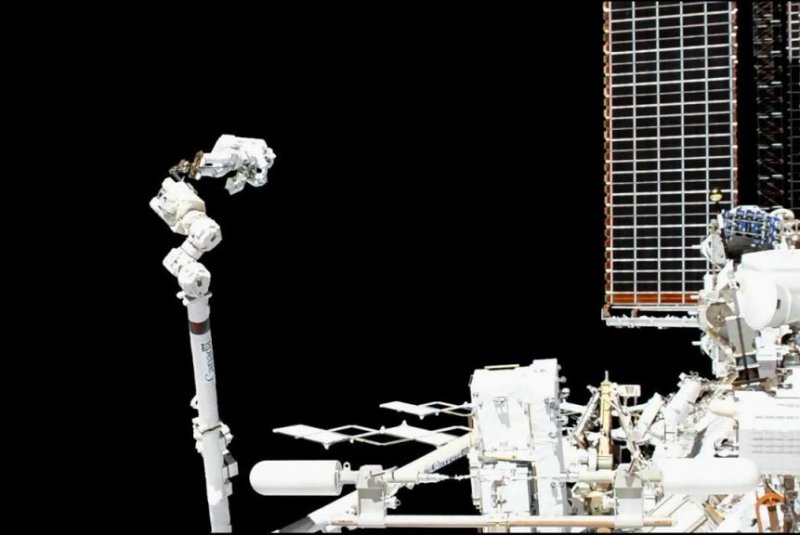Luca Parmitano of the European Space Agency is shown attached to the Canadarm during the first of a series of spacewalk missions aimed at repairing the Alpha Magnetic Spectrometer. Photo by NASA TV
Nov. 15 (UPI) -- NASA astronaut Andrew Morgan and European Space Agency astronaut Luca Parmitano are back inside the space station after a spacewalk that lasted six hours and 39 minutes.
The spacewalk switched their spacesuits to battery power at 6:39 a.m. ET on Friday morning, starting the clock on the first in a series of challenging spacewalks. They returned to the space station and removed their spacesuits at 1:18 p.m.
During their time outside the International Space Station, Morgan and Parmitano began preliminary work related to the repair of the cosmic particle detector. Their efforts were broadcast live on NASA TV.
The duo didn't actually fix the device, but their work will make it possible to fix the detector during future spacewalk missions -- spacewalks that NASA says will be especially complicated.
Next Friday, Morgan and Parmitano will once again venture outside the space station, this time to -- according to NASA -- "access, cut, and label the stainless steel tubes that attach the current cooling system" to the cosmic particle detector.
"These spacewalks are considered the most complex of their kind since the Hubble Space Telescope servicing missions, which took place between 1993 and 2009," NASA reported last week.
The cosmic particle detector, officially named the Alpha Magnetic Spectrometer, is an experimental device designed to detect antimatter in cosmic rays. Data collected by the AMS could help scientists determine the mysterious makeup of dark matter, which accounts for most of the mass in the universe.
When engineers designed the device, they didn't conceive of in-service repairs. But the technology's cooling component is broken and needs to be replaced for the experiment to continue.
"When we first started this, we weren't really sure if we were going to be able to complete the repairs successfully," Tara Jochim, AMS spacewalk repair project manager at NASA's Johnson Space Center, said during a recent press briefing. "Usually when you go out for a spacewalk, you're working on a piece of hardware that was prepared for, on the ground, for a spacewalk."
The AMS was originally designed for a three-year mission, but the device has continued past its end date, and engineers want to prolong it further.
"More than 20 unique tools were designed for the intricate repair work, which will include the cutting and splicing of eight cooling tubes to be connected to the new system and reconnection of a myriad of power and data cables," according to NASA. "Astronauts have never cut and reconnected fluid lines during a spacewalk."
If the repair missions are successful, the AMS will be able to continue collecting data through 2030.















